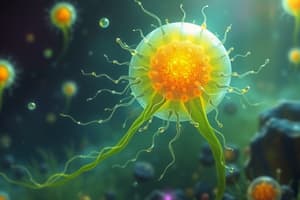Podcast
Questions and Answers
What characteristic distinguishes amoebas from other protists?
What characteristic distinguishes amoebas from other protists?
- They move using pseudopods. (correct)
- They live in aquatic environments.
- They have cell walls.
- They can perform photosynthesis.
Which feature is unique to Paramecia compared to other protists?
Which feature is unique to Paramecia compared to other protists?
- They have an oral groove for feeding. (correct)
- They have chloroplasts.
- They move using cilia. (correct)
- They can perform both autotrophic and heterotrophic functions.
How do Euglena obtain food when there is enough sunlight?
How do Euglena obtain food when there is enough sunlight?
- They absorb nutrients directly through their cell membrane.
- They consume food particles through an oral groove.
- They perform photosynthesis using their chloroplasts. (correct)
- They store food in a food vacuole.
What is the primary function of the contractile vacuole in protists like Paramecia and Euglena?
What is the primary function of the contractile vacuole in protists like Paramecia and Euglena?
Why are Volvox classified as plant-like protists?
Why are Volvox classified as plant-like protists?
Study Notes
Overview of Protists
- Single-celled organisms distinct from plants, animals, bacteria, and fungi.
- Classified as eukaryotes, primarily unicellular.
- Can be autotrophic (self-feeding) or heterotrophic (require external food sources).
Heterotrophic Protists
-
Amoeba
- Move using pseudopods (temporary projections of the cell).
- Lack cell walls, allowing flexibility in movement.
- Acquire food through a food vacuole, where digestion occurs.
-
Paramecia
- Live in aquatic environments, characterized by their single-celled structure.
- Propel themselves using cilia, tiny hair-like structures.
- Maintain water balance with a contractile vacuole.
- Utilize an oral groove to intake food.
Autotrophic Protists
-
Volvox
- Autotrophic organism containing chloroplasts for photosynthesis.
- Moves with two flagella, enabling propulsion.
- Regulates water levels using a contractile vacuole.
- Features an eyespot to detect light for optimal photosynthesis.
-
Euglena
- Lives in ponds and puddles, capable of both autotrophy and heterotrophy.
- Can perform photosynthesis when sunlight is available.
- Captures food particles using a cell membrane to form a digestive vacuole.
- Utilizes flagella for movement and possesses chloroplasts for photosynthesis.
- Contains an eyespot for light detection and a contractile vacuole for water regulation.
Studying That Suits You
Use AI to generate personalized quizzes and flashcards to suit your learning preferences.
Description
Explore the fascinating world of protists, from single-celled organisms to their diverse feeding strategies. This quiz covers both autotrophic and heterotrophic protists like amoeba, paramecia, and volvox, emphasizing their unique adaptations and characteristics.




